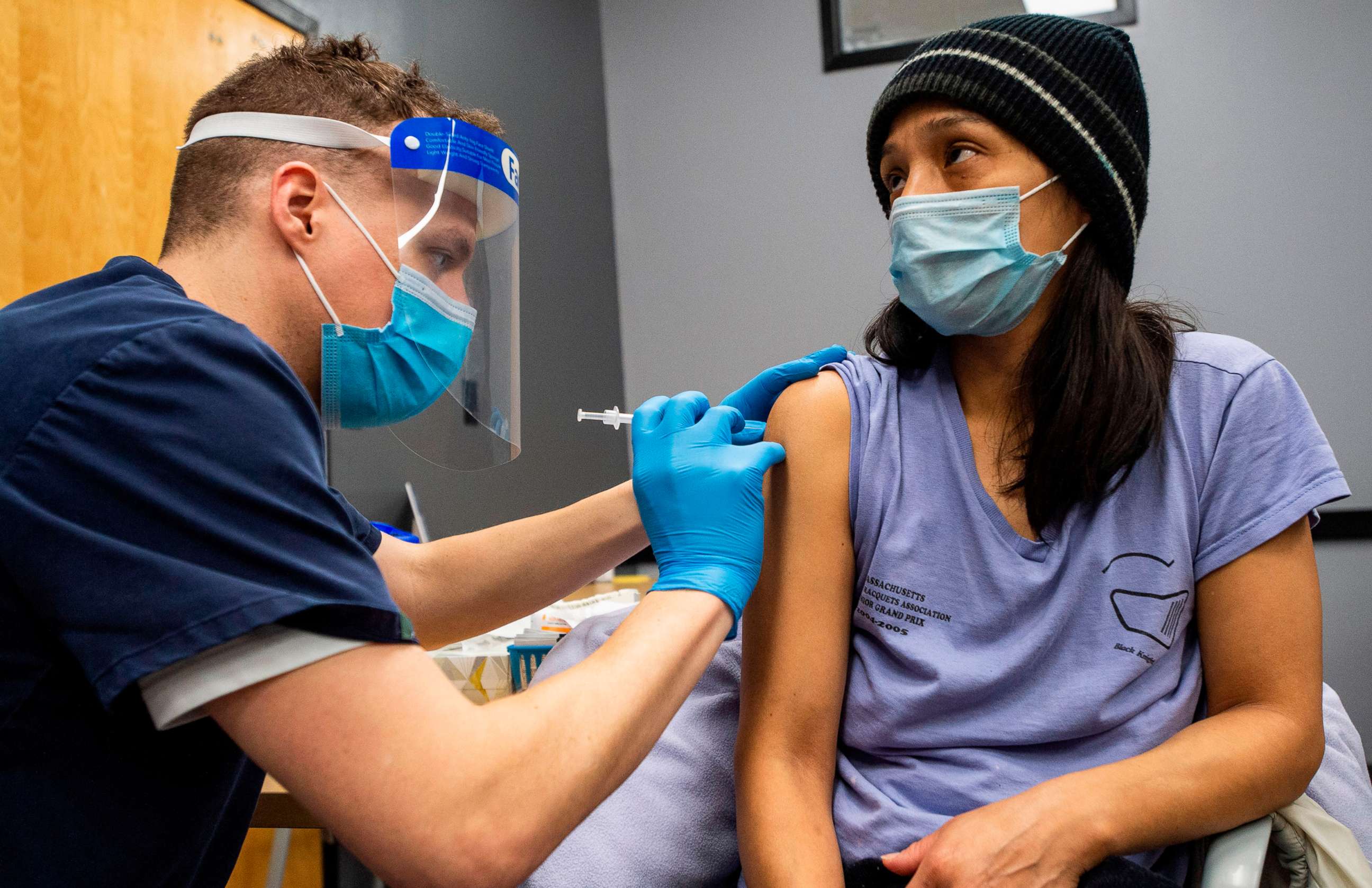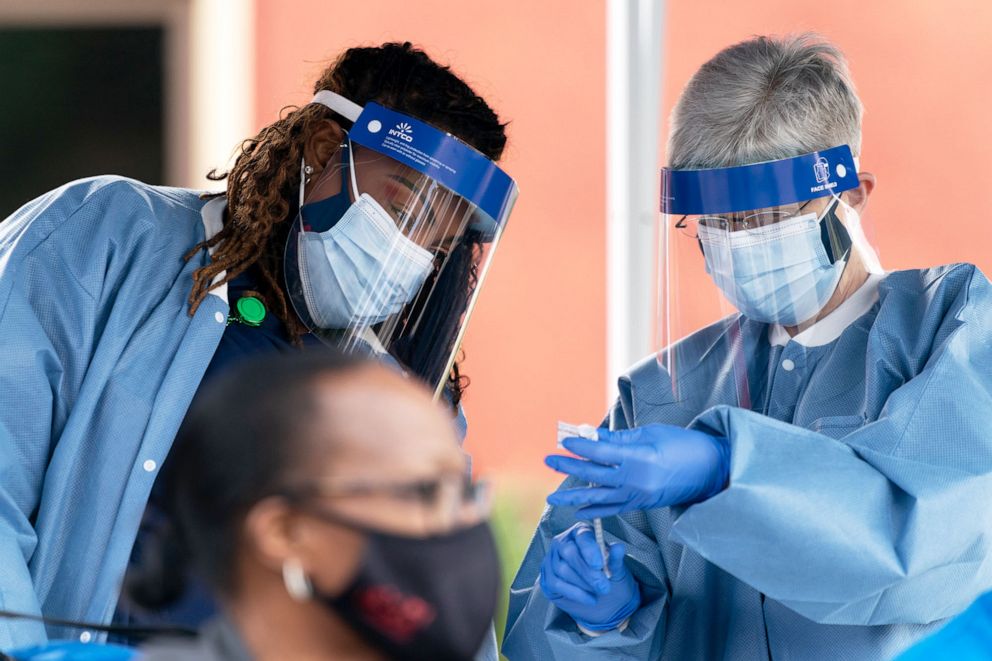3 things scientists have learned about vaccine hesitancy: Analysis
Vaccine hesitancy rates have been dropping, but many are still wary of the shot.
More than a year into the coronavirus pandemic, Americans may be finally seeing the light at the end of the tunnel. More than a quarter of the county has been fully vaccinated, and more than 200 million COVID-19 vaccine shots have been administered as of April 16.
As of Monday, all adults in the country -- not just those most vulnerable to the virus -- are eligible to get vaccinated.
But a troubling challenge remains in a country that has access to millions of doses while some nations still have none. A sizable portion of the population has what experts call "vaccine hesitancy."
On Monday, the hesitancy that so many people feel about the vaccine pushed President Joe Biden to plead with Americans to get the jab.
"Folks, I have good news," Biden said in a Twitter video. "Everybody is eligible as of today to get the vaccine. We have enough of it, you need to be protected, and you need in turn to protect your neighbors and your family."
"So please get the vaccine," the president said.
Data collected by the Centers for Disease Control and Prevention (CDC) offers a glimpse into which communities show the highest rates of vaccine hesitancy, bringing a clearer view of how much work needs to be done to vaccinate as many Americans as possible in the coming months. Estimated vaccine hesitancy rates were calculated based on Census Bureau survey data detailing the percentage of adults who described themselves as "probably not" or "definitely not" likely to get a COVID-19 vaccine once one is available to them.
According to an ABC News analysis of the county-level data, vaccine hesitancy is estimated to be higher in rural parts of the country, especially in western states including Wyoming, North Dakota and Idaho, as well as in southern states like Mississippi, Tennessee and Georgia. Hesitancy is also estimated to be higher where COVID-19 cases are the highest -- and in some of the most underserved parts of the country where vaccines are needed the most.
On a positive note, the census data shows that vaccine hesitancy rates have been going down over the past few months, with the percentage of those who are hesitant or strongly hesitant about the vaccine dropping from 21.5% in mid-January to 15.6% in late March.
But as of last month there were still more than a dozen states where more than a fifth of the population was hesitant to get vaccinated due to concerns about side effects and vaccine safety, according to the survey data.

Experts say vaccine hesitancy is a complex and multifaceted issue, and that the survey estimates are only intended to capture high-level sentiment within different geographic regions at a given time -- and do not account for factors such as cultural norms, social influences and political views.
Dr. Jay Bhatt, a Chicago internist and ABC News contributor, said that some people are "vaccine confident" while others may be "vaccine curious." Bhatt said that a lack of knowledge about the vaccines -- as well as the lack of access -- can be significant hurdles.
"It reinforces the message that we need to work harder and be more creative in meeting people where they live, learn, work, worship and play to get vaccinations done in high-risk communities," said Bhatt.
Where is hesitancy the highest?
Eight states lead the way in hesitancy, with more than one in every four people estimated to be hesitant about getting vaccinated, according to the data. Wyoming, North Dakota and Mississippi lead the group, with an average of nearly 30% of the population in each county estimated to be hesitant about vaccination, followed by Idaho, Tennessee, Montana, Georgia and Louisiana.

In Wyoming, Mississippi and North Dakota, in particular, every single county had an estimated hesitancy rate of more than 25%. Tennessee followed, with 81 out of its 95 counties showing at least 25% estimated rates.
In North Dakota, one in every five people was estimated to be strongly hesitant to get vaccinated, while in another dozen states, one in every five people was estimated to be hesitant, the analysis shows.
The ABC News analysis is in line with numerous other studies that have shown that people living in red states and in rural states are less willing to receive a vaccine. Early hesitancy in those states contributed to them having a glut of vaccines, which led several of them to become the first states in the nation to open up vaccines to the broader population.
On average, data from the smaller, largely rural counties that former President Donald Trump won during the 2020 presidential election shows that about 20% of adults are on the fence about being vaccinated -- which is about three percentage points higher than the number of vaccine-hesitant adults in larger, more populated counties that voted for President Biden.
And although Trump himself has gotten vaccinated, repeated polling has shown that many of his followers are highly skeptical of COVID-19 vaccines.
Who is more likely to be hesitant?
Vaccine hesitancy is also estimated to be highest in some of the more underserved parts of the country.
In counties with higher rates of estimated hesitancy -- more than 25% -- the average median household income is just over $47,000, data shows. In contrast, counties with lower hesitancy rates -- less than 15% -- have an average median household income of nearly $70,000.
Of the 10 poorest counties in the nation -- all of which are in the South -- nine have an estimated hesitancy rate of more than 23%.
Among counties whose population is more than 90% white, only about one in eight counties have estimated hesitancy rates of 25% or higher. But among predominantly nonwhite counties, one in four counties have estimated hesitancy rates of 25% or higher -- nearly double the rate of mostly white counties.
And the data shows that Black Americans, who have been disproportionately impacted by the virus, have been vaccinated at rates substantially lower than white Americans, due in many cases to an historically rooted mistrust of the medical system. In addition, a lack of access to medical care for underserved communities, followed by a lack of a relationship with a doctor or a team of health care providers, as well as a lack of geographical accessibility to a vaccination site and even difficulties getting out of work to get vaccinated all contribute to increased hesitancy.
Dr. John Brownstein, an epidemiologist and ABC News contributor, said that among minority communities there is a well-founded distrust of government, the medical establishment, and even academic researchers -- which is likely to directly impact vaccine decisions.
"Vaccine hesitancy will continue to persist among historically marginalized populations unless significant resources in communications and access are deployed," Brownstein said
Counties with the highest estimated hesitancy rates also tend to be slightly younger. In the 10 counties with the lowest median age -- all under 25 years old -- vaccine hesitancy averages 20%.
"We have seen that the highest vaccine hesitancy exists in younger adult populations," Brownstein said. "By making immunization decisions based on individual risk alone, the younger population is likely ignoring the broader public health benefit for widespread vaccination to achieve herd immunity."
What do we see in places with high hesitancy?
As expected, the number of COVID-19 cases is higher in counties where the hesitancy rate is highest.
According to the analysis, counties with estimated vaccine hesitancy rates of 25% or higher in mid-April averaged 10,974 coronavirus cases per 100,000 people.
In contrast, counties where estimated hesitancy rates were less than 15% averaged only 7,792 cases per 100,000.
And in five out of the 10 counties in the nation where the rate of COVID-19 cases was the highest as of mid-April -- including Chattahoochee County in Georgia, Dewey County in South Dakota, Trousdale and Lake counties in Tennessee, and Bethel Census Area in Alaska -- one in four adults were estimated to be hesitant about getting vaccinated.
Brownstein said it's not surprising to see higher rates of hesitancy in places that are also experiencing the worst of the pandemic.
"Vaccine hesitancy may stem from an overall skepticism about the seriousness of the pandemic," Brownstein said. "We expect that low adherence to masking and social distancing, which we know can drive transmission down, would correlate with a lack of recognition of the importance of vaccine."